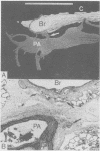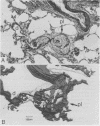Abstract
Three dimensional computer aided reconstructions of pulmonary vessels were used to investigate the distribution of vascular changes and the formation of collateral channels in 11 patients with congenital heart disease. In the patients with less severe grades of hypertensive pulmonary vascular disease obstructive changes were unevenly distributed, whereas in those with disease of grade 4 or more distribution became more even. Plexiform lesions occurred rather more frequently in supernumerary arteries arising laterally from a large parent vessel, whereas cellular or fibrous intimal thickening tended to affect dichotomous branches at the periphery. Hypertensive changes were confined to arteries of 100-150 microns diameter running along the necks of acini. Various types of collateral channels were found. In particular, the reconstructions suggest that pulmonary arterial blood at high pressure could flow into bronchial arteries via proximal bronchopulmonary arterial anastomoses, and thence by way of dilatation lesions to the alveolar capillaries.
Full text
PDF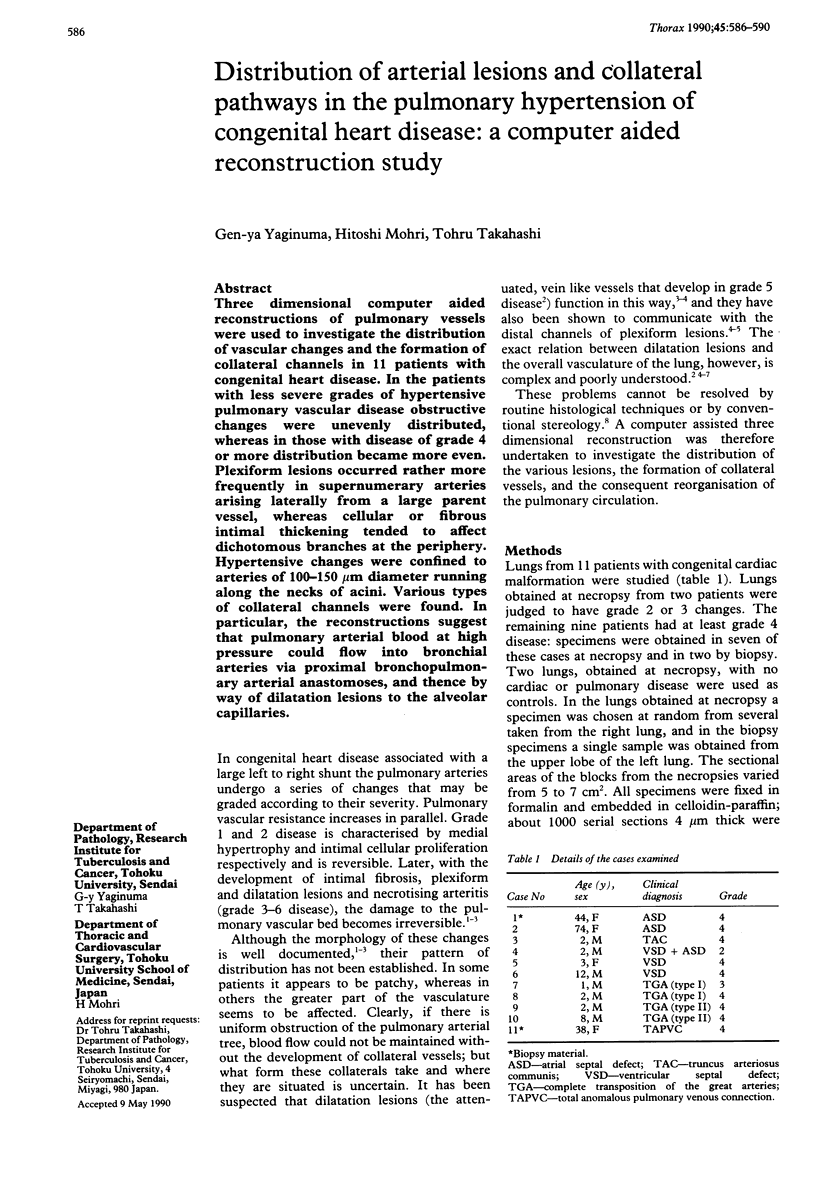
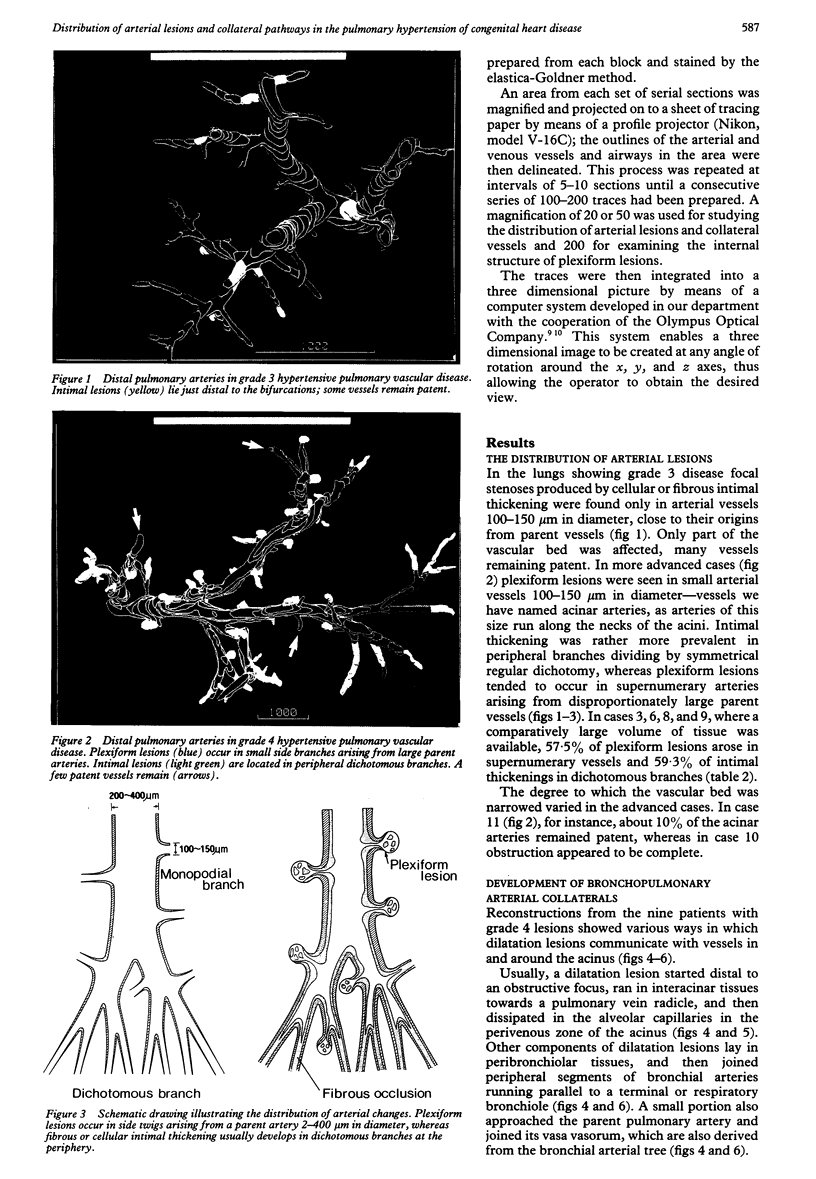
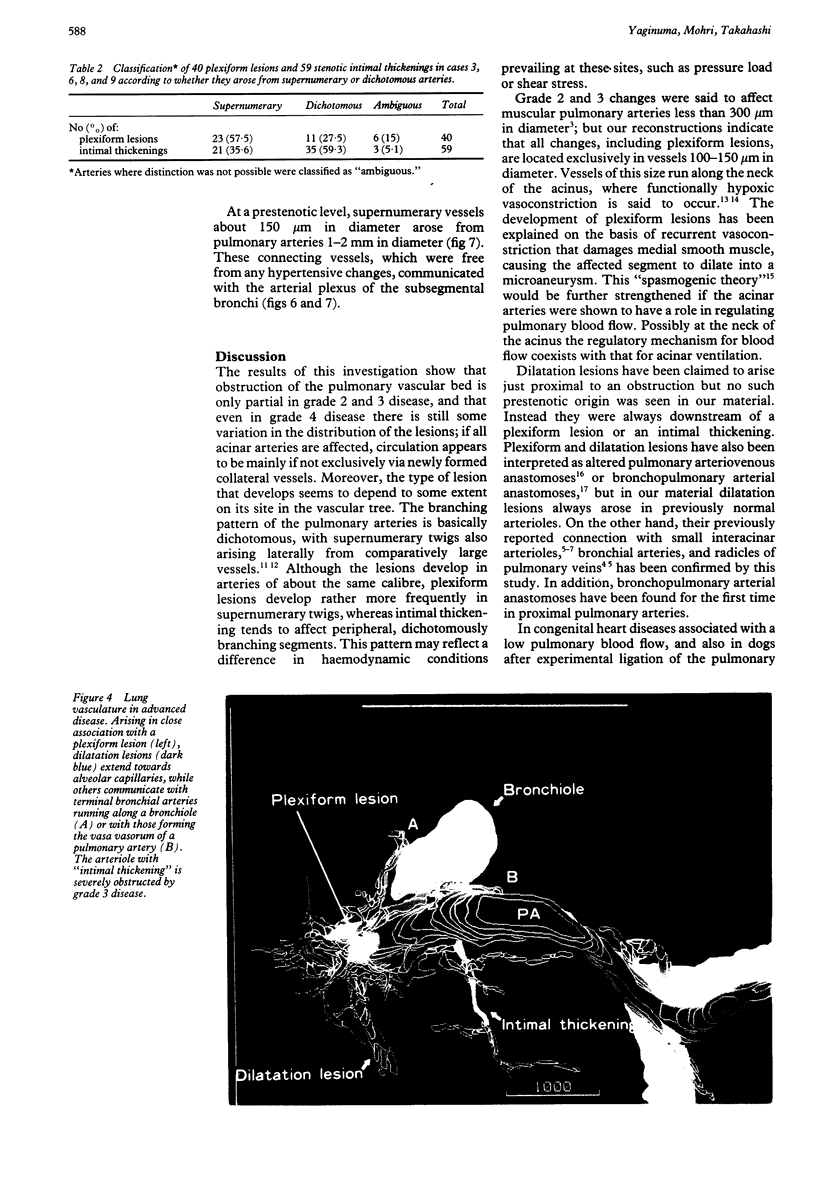


Images in this article
Selected References
These references are in PubMed. This may not be the complete list of references from this article.
- BREWER D. B. Fibrous occlusion and anastomosis of the pulmonary vessels in a case of pulmonary hypertension associated with patent ductus arteriosus. J Pathol Bacteriol. 1955 Oct;70(2):299–310. doi: 10.1002/path.1700700205. [DOI] [PubMed] [Google Scholar]
- BREWER D. B., HEATH D. Pulmonary vascular changes in Eisenmenger's complex. J Pathol Bacteriol. 1959 Jan;77(1):141–147. doi: 10.1002/path.1700770115. [DOI] [PubMed] [Google Scholar]
- BRINTON W. D. Primary pulmonary hypertension. Br Heart J. 1950 Jul;12(3):305–311. doi: 10.1136/hrt.12.3.305. [DOI] [PMC free article] [PubMed] [Google Scholar]
- CUDKOWICZ L. The blood supply of the lung in pulmonary tuberculosis. Thorax. 1952 Sep;7(3):270–276. doi: 10.1136/thx.7.3.270. [DOI] [PMC free article] [PubMed] [Google Scholar]
- DOWNING S. E., VIDONE R. A., BRANDT H. M., LIEBOW A. A. THE PATHOGENESIS OF VASCULAR LESIONS IN EXPERIMENTAL HYPERKINETIC PULMONARY HYPERTENSION. Am J Pathol. 1963 Nov;43:739–765. [PMC free article] [PubMed] [Google Scholar]
- ELLIOTT F. M., REID L. SOME NEW FACTS ABOUT THE PULMONARY ARTERY AND ITS BRANCHING PATTERN. Clin Radiol. 1965 Jul;16:193–198. doi: 10.1016/s0009-9260(65)80042-3. [DOI] [PubMed] [Google Scholar]
- FISHMAN A. P., TURINO G. M., BRANDFONBRENER M., HIMMELSTEIN A. The effective pulmonary collateral blood flow in man. J Clin Invest. 1958 Jul;37(7):1071–1086. doi: 10.1172/JCI103688. [DOI] [PMC free article] [PubMed] [Google Scholar]
- Friedman P. J. Direct magnification angiography and correlative pathophysiology in experimental pulmonary hypertension. Invest Radiol. 1972 Nov-Dec;7(6):474–495. doi: 10.1097/00004424-197211000-00004. [DOI] [PubMed] [Google Scholar]
- HEATH D., EDWARDS J. E. The pathology of hypertensive pulmonary vascular disease; a description of six grades of structural changes in the pulmonary arteries with special reference to congenital cardiac septal defects. Circulation. 1958 Oct;18(4 Pt 1):533–547. doi: 10.1161/01.cir.18.4.533. [DOI] [PubMed] [Google Scholar]
- Kato M., Staub N. C. Response of small pulmonary arteries to unilobar hypoxia and hypercapnia. Circ Res. 1966 Aug;19(2):426–440. doi: 10.1161/01.res.19.2.426. [DOI] [PubMed] [Google Scholar]
- Koyama T., Horimoto M. Blood flow reduction in local pulmonary microvessels during acute hypoxia imposed on a small fraction of the lung. Respir Physiol. 1983 May;52(2):181–189. doi: 10.1016/0034-5687(83)90004-x. [DOI] [PubMed] [Google Scholar]
- LIEBOW A. A., HALES M. R. Studies on the lung after ligation of the pulmonary artery; anatomical changes. Am J Pathol. 1950 Mar;26(2):177–195. [PMC free article] [PubMed] [Google Scholar]
- MARCHAND P., GILROY J. C., WILSON V. H. An anatomical study of the bronchial vascular system and its variations in disease. Thorax. 1950 Sep;5(3):207–221. doi: 10.1136/thx.5.3.207. [DOI] [PMC free article] [PubMed] [Google Scholar]
- NAEYE R. L., VENNART G. P. The structure and significance of pulmonary plexiform structures. Am J Pathol. 1960 May;36:593–605. [PMC free article] [PubMed] [Google Scholar]
- NAKAMURA T., KATORI R., MIYAZAWA K., OHTOMO S., WATANABE T., WATANABE T., MIURA Y., TAKIZAWA T. Bronchial blood flow in patients with chronic pulmonary disease and its influences upon respiration and circulation. Dis Chest. 1961 Feb;39:193–206. doi: 10.1378/chest.39.2.193. [DOI] [PubMed] [Google Scholar]
- Robertson B. The normal intrapulmonary arterial pattern in infancy and early childhood. A micro-angiographic and histological study. Acta Pathol Microbiol Scand. 1967;71(4):481–501. doi: 10.1111/j.1699-0463.1967.tb05171.x. [DOI] [PubMed] [Google Scholar]
- SPENCER H. Primary pulmonary hypertension and related vascular changes in the lungs. J Pathol Bacteriol. 1950 Jan;62(1):75–84. doi: 10.1002/path.1700620111. [DOI] [PubMed] [Google Scholar]
- Saldaña M. E., Harley R. A., Liebow A. A., Carrington C. B. Experimental extreme pulmonary hypertension and vascular disease in relation to polycythemia. Am J Pathol. 1968 May;52(5):935–981. [PMC free article] [PubMed] [Google Scholar]
- Yaegashi H., Takahashi T., Kawasaki M. Microcomputer-aided reconstruction: a system designed for the study of 3-D microstructure in histology and histopathology. J Microsc. 1987 Apr;146(Pt 1):55–65. doi: 10.1111/j.1365-2818.1987.tb01326.x. [DOI] [PubMed] [Google Scholar]






